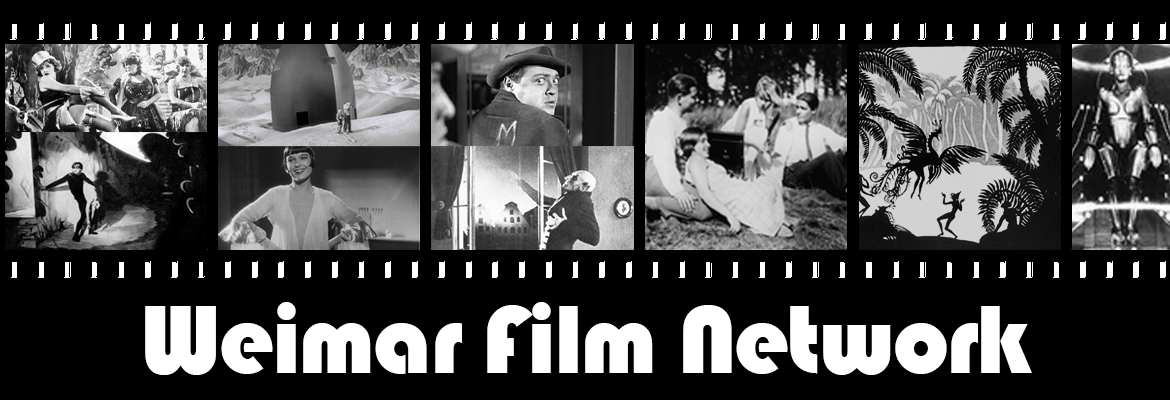M – A Milestone of Sound Film
Fiona Bumann, Ludwig-Maximilians-Universität
When the first sound films were shown in Weimar cinemas in 1929, a new era full of creative possibilities began for German film production. When Fritz Lang released his first sound film M – Eine Stadt sucht einen Mörder (1931), he adopted the new medium with confidence and made it an integral part of moving the plot forward. M has become known worldwide as an artistic piece which celebrates the union of image and sound.
The additional title, Eine Stadt sucht einen Mörder, implies the basic storyline of the film. Horrified by the deeds of an apparently ruthless murderer (Peter Lorre) who kills little girls, a city begins to search for the perpetrator. Although individuals play an important part in the film, it seems as if the city is the true protagonist, engaging in the search as one always vigilant being. Several scenes show suspicion eating up the citizens, who all suspect and condemn one another, but the real killer cannot be found. Peter Lorre as the murderer is known to the audience from the beginning. However, this does not diminish the effect of tension created, among other things, by the actor’s idiosyncratic performance. With ease he switches between ‘nice uncle’ and madman and it is especially Lorre’s art of facial expressions, at one moment kind and amiable and in another horribly distorted, that leaves the viewer in the conflicted position of not knowing what to make of this character: as repugnant as he should be, M has moments of pity in store for him.
Especially for audiences in the Weimar Republic, M must have offered a certain cruel topicality. With the film opening on a group of children, chanting the Haarmann-Lied, it is not implausible that the cinema-goer would be reminded of the mass-murders of Fritz Haarmann which disturbed the country in the mid-1920s. Weimar Germany became a place of hysteria and perverse fascination with crime, which Lang tries to bring into his film.
The manhunt is led by two independent parties who act for different reasons and each of them employs the city for its own purpose: the police (with Otto Wernicke as detective inspector Karl Lohmann) and a group of criminals (with Gustav Gründgens as the group’s leader Schränker). A race begins - against each other andagainst time itself before another murder occurs. In some ways it is even a competition between image and sound through the different means of investigation used by the two groups. The police focus on the visual search for clues and the criminals on the aural one, putting the city under total surveillance. The winner is apparent. Lang emphasises the importance of sound by the ironic presentation of the blind beggar as the only one able to recognize the murderer by his peculiar whistling tune – Edvard Grieg’s In the Hall of the Mountain King. This tune perfectly sets the nervous restlessness that Peter Lorre’s murderer embodies to music and with it comes a tense expectation for something ominous. In fact, In the Hall of the Mountain King serves as the indicator of an impending murder and moreover forms the private soundtrack and the aural leitmotif of the film.
However, Lang proves his extraordinary understanding of the new medium, not only with his knowledge of how to apply sound, but also when not to use it. In the first nine minutes of the film the audience watches an interplay of scenes showing a mother preparing supper for her daughter Elsie. However, on her way home from school, Elsie meets the murderer. These scenes are connected only through the use of sound. The noises of the city are similar to the sounds that can be heard from the small apartment, each shifting into the other. And then, after all noise, the audience experiences complete silence. A series of images follows, amongst them an image of the ball that Elsie was playing with rolling into the grass, and still, everything is quiet. In Lang’s film, death has no voice. In this silence, the story of a child’s murder is being told, a story for which there are no words. Lang’s sudden silences are the most impressive scenes, creating the feeling of horror, terror and pain and showing that sometimes silence can and does speak loudest.
M is not only concerned with the issues of its time, it is also a milestone in German sound film. Lang combines with excellent skill sound and image and shows the importance of their interplay, creating the thrilling chase of a murderer.
Consulted Work
Brockmann, Stephen, ‘M (1931) or Sound and Terror’, in, A Critical History of German Film (Suffolk: Boydell & Brewer, Incorporated, 2010), pp. 113-127

